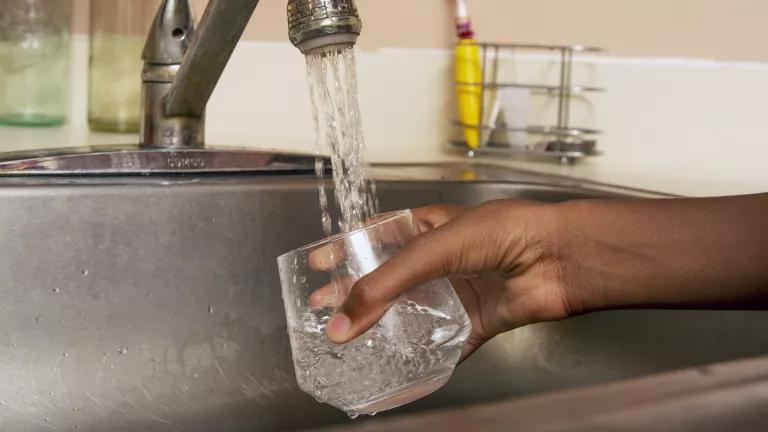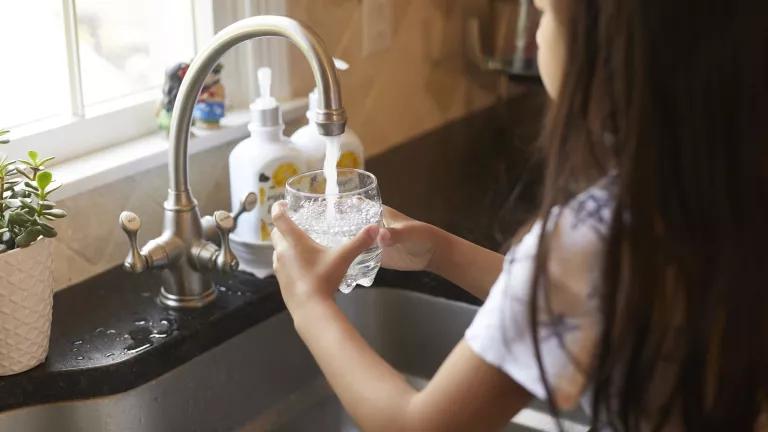Locations of High Lead Levels in Newark’s Water Identified
The State has estimated that there are approximately 22,100 homes in Newark with lead service lines.

The lead levels in Newark, New Jersey’s drinking water are among the highest recorded by a large water system in the United States in recent years. In 2017, more than 26 parts per billion (ppb) of lead was found in 10 percent of the City’s tap water samples, and 20 percent of samples exceeded the 15 ppb action level set by the federal Environmental Protection Agency. At certain Newark homes, lead was found at much higher concentrations. At least nine homes tested above 50 ppb, and one home tested at 137 ppb. The lead levels in Newark’s drinking water are so high that the State environmental agency—the New Jersey Department of Environmental Protection—issued notices of noncompliance to the City of Newark in June 2017 and January 2018.
For months, the City and the State refused to disclose the locations of the highest lead levels measured in Newark. That changed in late April, when NRDC filed a complaint asking the New Jersey Superior Court to require the City to release the water sampling locations, so that Newark residents could be fully notified about risks they face. Although the City continues to withhold information, Columbia Law School's Environmental Law Clinic, working on behalf of NRDC, recently convinced the State to provide some of the sampling data NRDC requested. That government data are shown here, on an overlay of a map of the City of Newark:
The data are concerning. Red dots on the map represent homes that tested above 15 ppb, in excess of the federal action level, between January 2017 and mid-April 2018. Homes with the highest levels of drinking water lead contamination are concentrated in the West, North, and South Wards. Other elevated sampling results are scattered throughout the East and Central Wards. The residents living in these homes are exposed to extremely high levels of lead in their drinking water. Exposure to these levels puts residents at risk of irreversible health effects, including reduced brain function, miscarriage in pregnant women, decreased fertility, cardiovascular and kidney problems, cognitive dysfunction, elevated blood pressure, among other serious impairments.
Yet, the 15 ppb lead action level (represented in red) is not a safety indicator. It is merely the level at which the City is required by federal law to take action to notify and protect residents. There is no safe level of lead exposure. So, although the homes represented by red dots on the map are experiencing the greatest risk from their drinking water, the homes represented by orange dots (lead levels between 10 and 15 ppb), yellow dots (lead levels between 5 and 10 ppb), and even green dots (lead levels between 0 and 5 ppb) on the map also face potential health effects.
We know that lead has devastating health effects at even low levels of exposure. According to the Centers for Disease Control and Prevention, exposure to low levels of lead early in life has “been found to affect behavior and intelligence.” These effects include lower IQ scores and academic performance, inattention, impulsivity, aggression, and hyperactivity. According to the Environmental Protection Agency, exposure to low levels of lead is “linked to damage to the central and peripheral nervous system, learning disabilities, shorter stature, impaired hearing, and impaired formation and function of blood cells.” For these reasons, the Environmental Protection Agency, Centers for Disease Control and Prevention, and World Health Organization all agree that there is no safe level of lead exposure. The American Academy of Pediatrics recommends a 1 ppb exposure limit, which many of the homes represented by green dots on the map may have well exceeded.
Equally concerning is how much of Newark has been left untested. The City is divided into block groups, which are census areas typically containing 600 to 3,000 people. Pink shading represents areas where at least one sample has been taken. In contrast, block groups where no testing has occurred are shown in gray. The majority of block groups—some in very old parts of the City where lead infrastructure and plumbing fixtures are likely—are gray, meaning the neighborhoods they cover have not been tested by the City at all. While it’s not a legal requirement to test every neighborhood, there’s no reason to expect the untested areas are untouched by the City’s lead crisis. It’s crucial that residents know the full scope of the problem.
Unfortunately, we know that lead-contaminated drinking water is not limited to a few households in Newark. The State has estimated that there are approximately 22,100 homes in Newark with lead service lines. Of the areas that were tested by the City, red, orange, and yellow results can be found throughout almost every block group. High levels of lead can be found near lower levels of lead, so residents residing in block groups that appear to have relatively low lead values are not necessarily in the clear and are still advised to have their water tested.
If you live in Newark and have not already had your home’s tap water tested for lead, you can request a free test from the Newark Department of Water and Sewer Utilities by calling 973-733-6303 or emailing waterandsewer@ci.newark.nj.us. If you prefer independent testing, Healthy Babies Bright Futures provides low-cost, pay what you can test kits.
For more guidance about how to protect yourself and your family, we have assembled the following resources:
If you are a resident of Newark and have questions or need more information, please email us at safewater4newark@nrdc.org.




